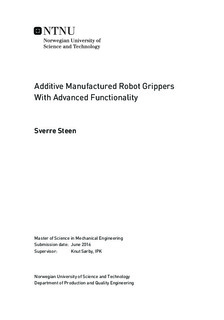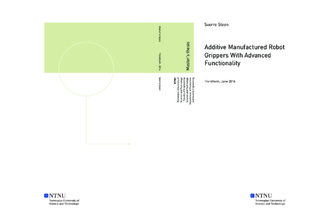| dc.description.abstract | Kongsberg Automotive produces injection molded parts. These are removed from the mold with a robot gripper. These robot grippers have grown larger as the complexity of the molds grew. This has increased the amount of collisions between the mold and the gripper. Kongsberg Automotive wants to find out if it is a possibility to use additive manufacturing to produce smaller and better grippers for their production lines.
During this thesis work a new design concept for robot grippers was developed. The purpose of this design is to reduce the production halts resulting from contact between the gripper assembly and its surrounding machinery, and to decrease the wear due to high moments of inertia imposing high loads on the assembly substructures. The design of the structural subunits is utilizing topology optimization. (Optistruct and Inspire by Altair)
This thesis is written in collaboration with Kongsberg Automotive, Raufoss. It has also developed and manufactured a prototype gripper that fits the injection molding tool and machinery used in production at Kongsberg Automotive, Raufoss. The gripper subassembly was manufactured using additive manufacturing of metal, utilizing powder bed fusion. The prototype is made from the aluminum alloy powder CL30AL, delivered by Concept Laser Co. specifically for use in additive manufacturing.
The design for the prototype was narrower than the currently used design, while fulfilling the demands to strength and stiffness. This gives the gripper sufficient room on all sides when it is inside the mold. It also has the quick change tool adapter build into the body of the part. It also has internal tubes for pressurized air to the pneumatic actuators. These significantly reduces the use of hoses which can snag on edges in the mold.
The Prototype produced showed some flaws and errors. This was a result from among other things internal stresses in the material during the build process. Many of these flaws could have been repaired by welding the cracks and patching the holes epoxy. Because of these errors there has not been enough time to test the prototype. | |

